This post may contain affiliate links, read my disclosure policy for details.
This classic Berry Pavlova Cake recipe is a beautiful but rustic looking dessert that is perfect for the holidays. The elegant dessert is crispy on the outside with a soft marshmallow texture inside! It’s sure to impress your guests. The ingredients list is short and most of the cooking is hands-off!
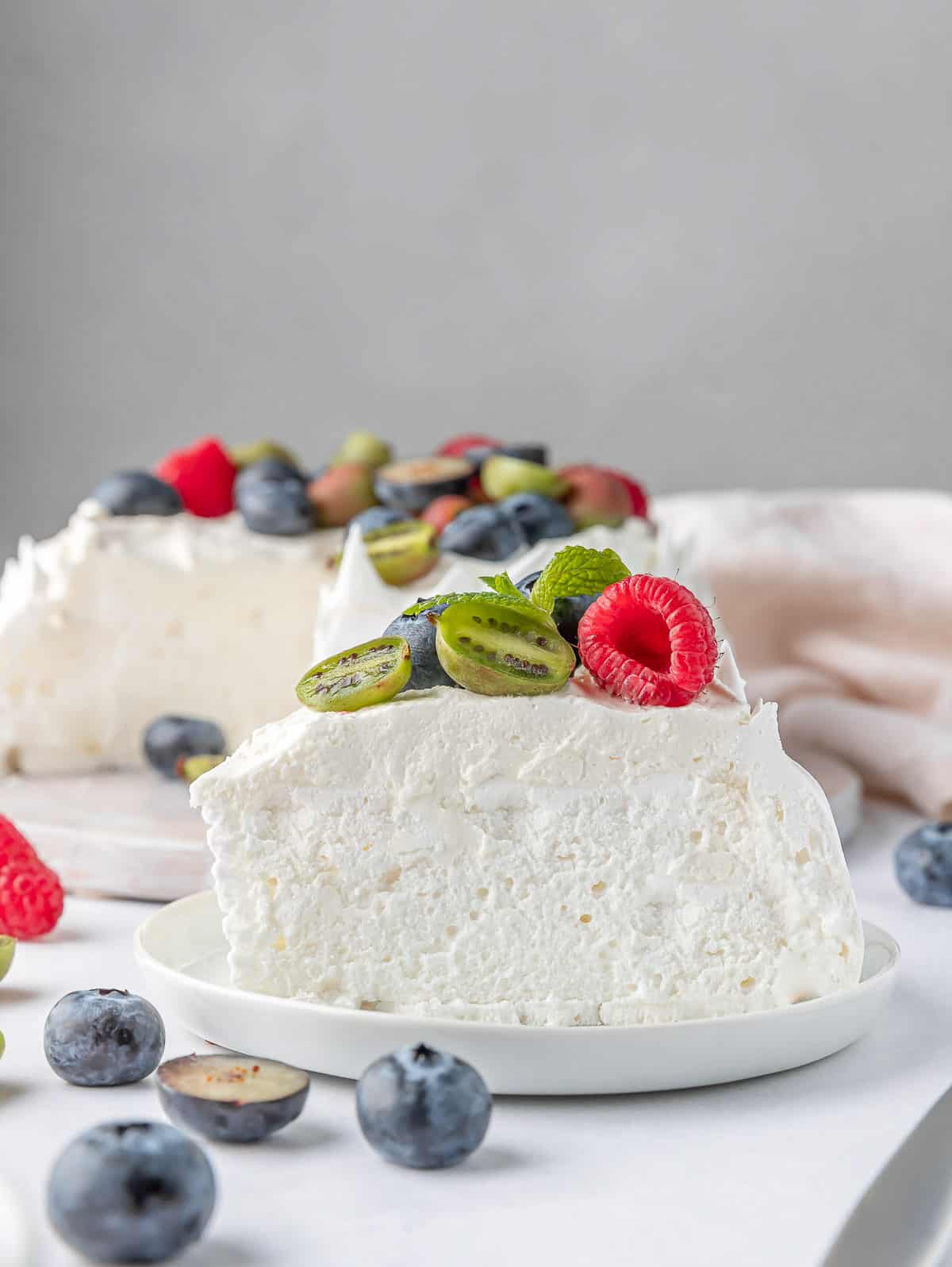
This meringue-based dessert is named after Anna Pavlova, a Russian ballerina, as her performances were as light and airy as this dessert. The delicate meringue crust may seem difficult to make but with my tips and tricks, you’ll perfect it in no time!
For another festive dessert that’s perfect for the holidays, I recommend trying my Pumpkin Cake Roll or Pumpkin Pie Cheesecake Bars. They’re especially perfect in the fall when pumpkin is in season during Thanksgiving or Christmas!
What is Pavlova?
Pavlova is a meringue-based dessert named after the Russian ballerina Anna Pavlova. It has a crisp crust and soft, light inside, usually topped with fruit and whipped cream. Even though is is name after the Russian ballerina, the recipe itself is not Russian as many think. It is a popular dish and an important part of the national cuisine of both Australia and New Zealand, and with it’s simple recipe, is frequently served during celebratory and holiday meals.
Why You’ll Love This Easy Pavlova Recipe
- It’s a show stopper. It’s definitely a dessert that will catch everyone’s eye when you bring it out!
- Uses pantry staples. The main ingredient is egg whites which I almost always have on hand. If not, I always have eggs on hand and can separate the yolks and save it for an omelet and use the whites!
- It’s perfect for the holidays. If you’ve always wanted to make a pavlova, then this holiday season is the best time to make this! It’s quite the festive treat.
Ingredients For Pavlova
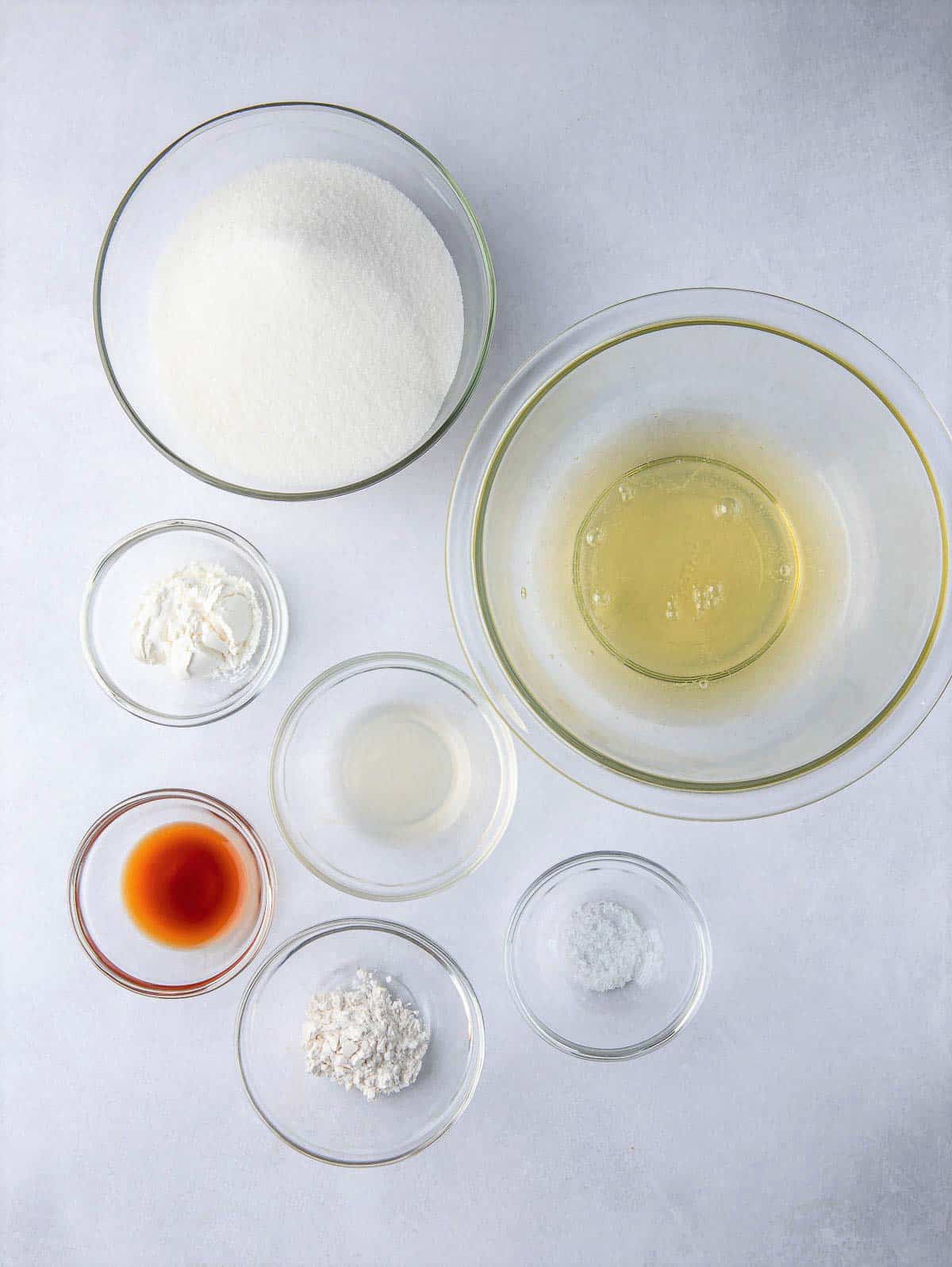
- Egg whites: bring them to room temperature.
- Caster sugar: you can substitute with powdered sugar.
- Cream of tartar: this helps stabilize the meringue.
- Vanilla extract: be sure to measure this as too much can affect the color.
- Lemon juice: use fresh lemon juice and not bottled.
- Corn starch: again, to help stabilize the pavlova.
Pavlova Cake Topping Ingredients
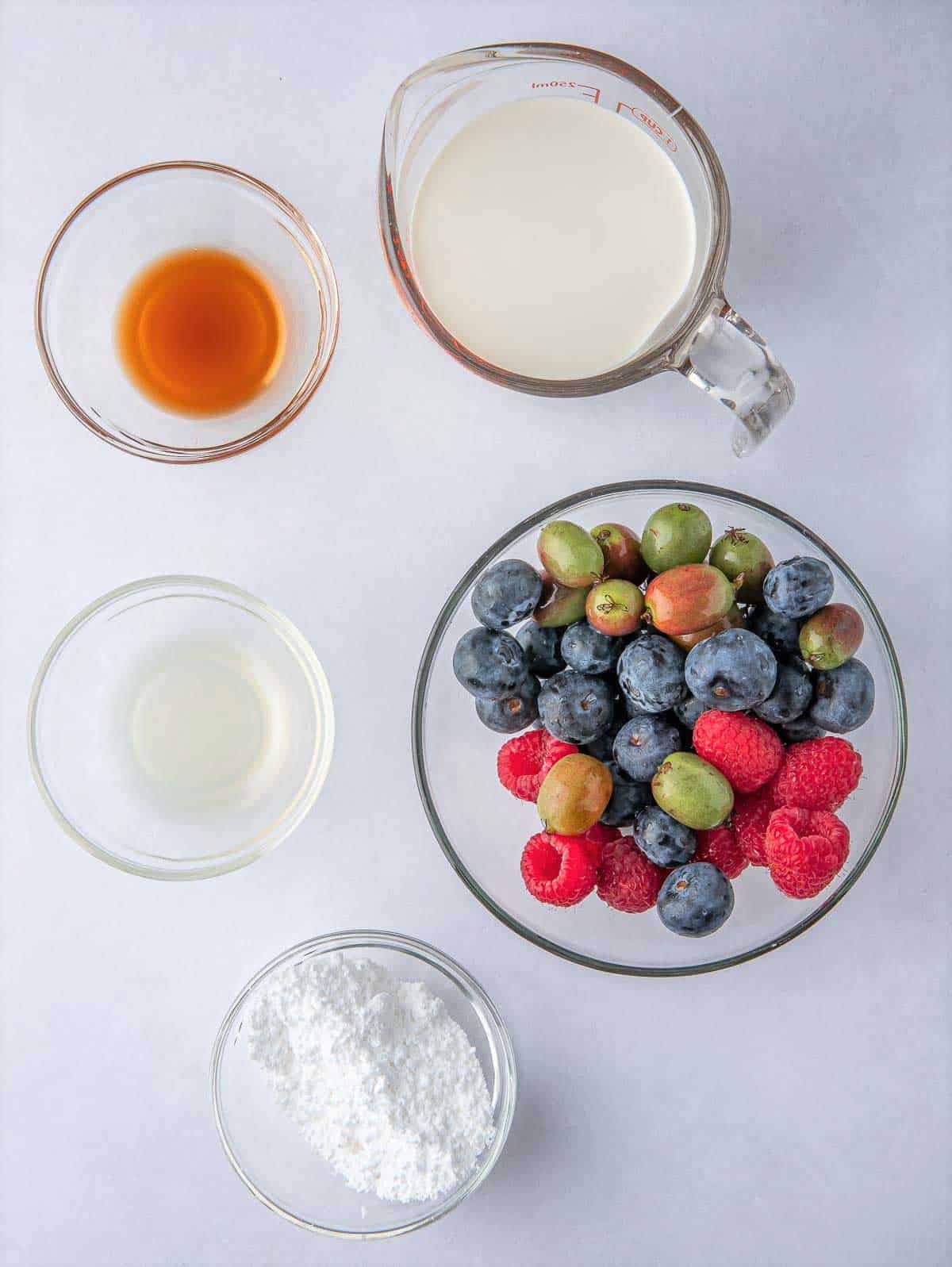
- Whipped cream: for fresh homemade whipped cream, you’ll need heavy whipping cream, powdered sugar, lemon juice, and vanilla extract.
- Fresh berries and fruits: for garnish.
How To Make a Pavlova
- Prepare the equipment: Preheat the oven to 250 F. With a pencil trace a 7” circle on a piece of parchment paper. Flip the traced side down and place parchment paper on the baking sheet. Dip a paper towel in a little bit of vinegar and run it thru the inside of the bowl and whisk. Wipe clean with another piece of dry paper towel.
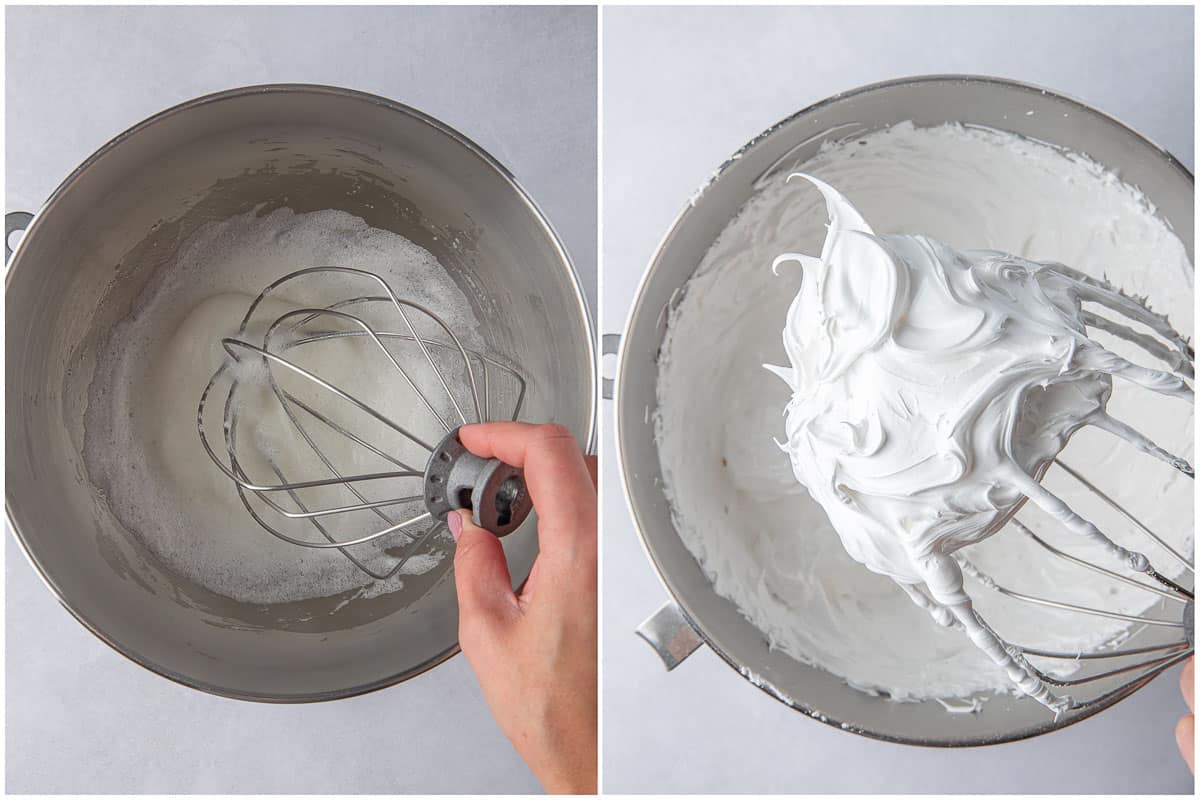
- Prepare the egg whites: In a cleaned bowl transfer room temperature egg whites and salt. Whisk on medium speed until frothy. Make sure to check the bottom of the bowl to make sure all the egg whites have become frothy. They will turn white in color but will be soft, yet they will start to leave whisk marks. No liquid egg white should be on the bottom of the bowl. Add cream of tartar and whisk to incorporate.
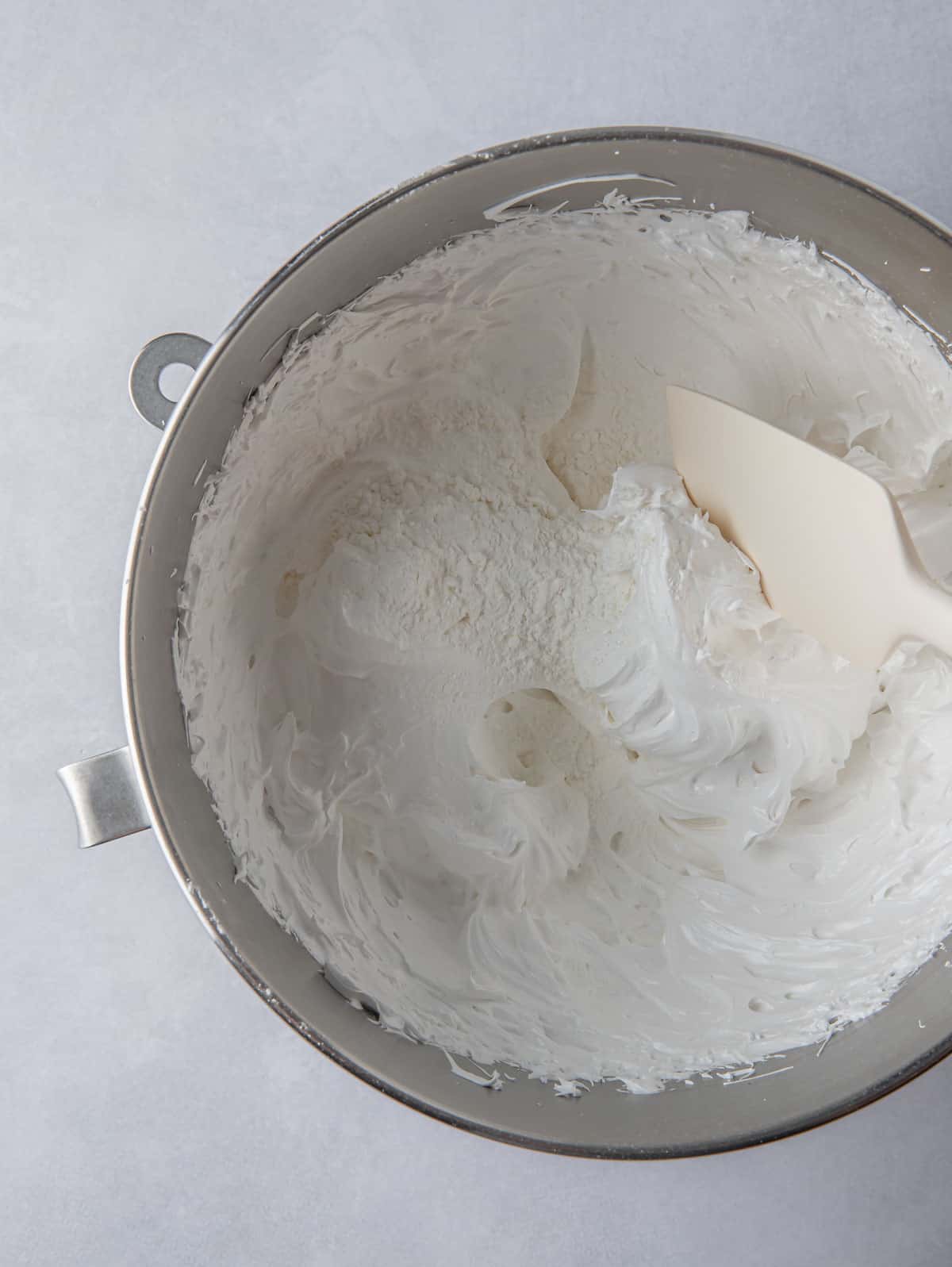
- Make the meringue: Turn the mixer speed to medium-high and start adding sugar one teaspoon at a time. Do so in 5-10 second increments. This is to ensure the sugar has time to dissolve and the meringue is not deflated by a large amount of sugar. Once all sugar is added, continue whisking until it completely dissolves. The mixture will be stiff and glossy. Add in lemon juice, vanilla, and cornstarch. Mix with the spatula to incorporate.
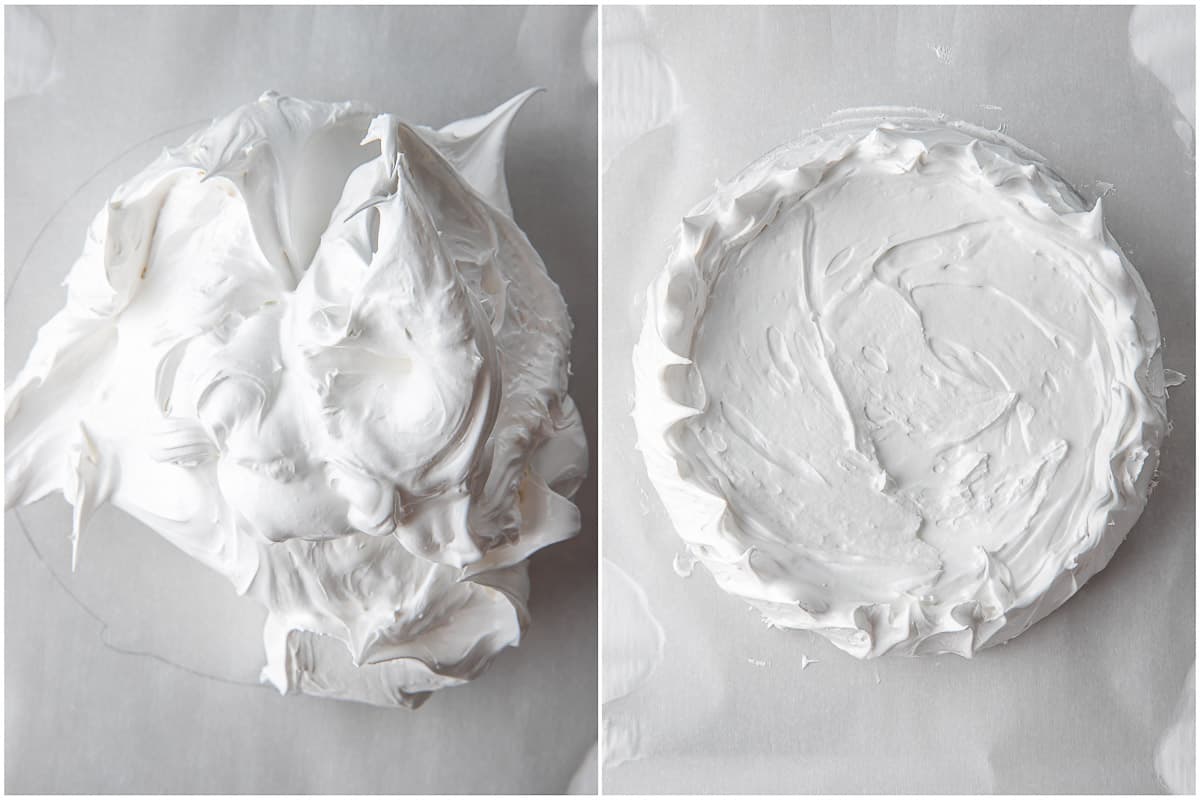
- Bake the pavlova: Spoon the meringue onto the prepared baking tray. Even it out with a palette knife until the traced circle is filled and you have an even layer of meringue. Place pavlova into the oven for 10 minutes. Make sure you place it in the middle rack or in the position where your oven has the most even heat. After ten minutes, without opening the oven, dial down the temperature to 200F and bake for 2 hours.
- Turn off the oven: Without opening the oven, turn off the heat and let the meringue cool down in the oven.
- Make the whipped cream: In a bowl of a stand mixer place heavy cream and whip until the soft peaks. Add powdered sugar and whip until thick. Don’t overwhip. Whisk in lemon juice and vanilla. Let it incorporate.
- Garnish the pavlova: Transfer the whipped cream on top of your pavlova cake. Top with fresh berries and fruits and serve right away.
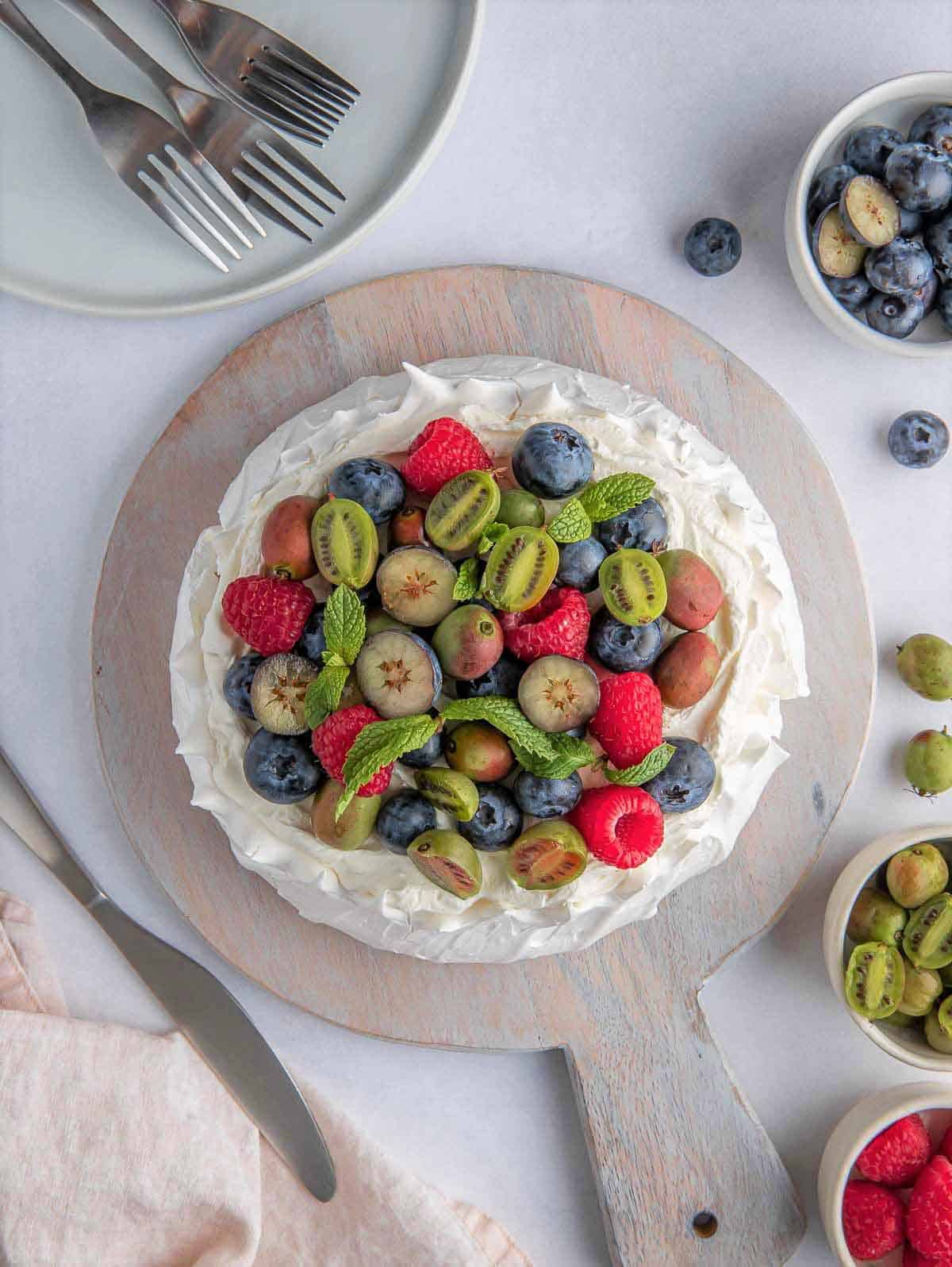
Tips to Make the Best Pavlova Cake
- Allow pavlovas to rest in the warm oven 30 minutes before removing them to make sure the exterior dries well.
- Be sure to preheat the oven so you can get the pavlovas right into the oven. Don’t like it sit out for long before baking of else the form of it will start melting.
- Pavlova Cake must be consumed the same day it is made. Leftovers must be refrigerated but they most likely will get soft and soggy.
- Egg whites whip better when at room temperature but they separate easier when cold. Plan ahead by separating the eggs beforehand and leaving the egg whites out so they come to room temperature.
- Make sure there are no egg yolks present in the egg whites as the fat from the egg yolks will affect the egg whites’ ability to create a foam-like structure.
- I highly recommend using a scale to get the right amount of egg whites. Eggs vary in size so the scale ensures that you can measure the whites accurately.
- The bowl must be clean and dry so the eggs can whip up effortlessly. Use a stainless steel or glass bowl if possible as plastic bowls can retain a film of grease from previous uses.
- Similarly, the utensils such as the whisk are dry as well.
Frequently Asked Questions
Meringues are tricky. There are lots of things that can go wrong, but the most frustrating is when you put the sugar in too fast and it takes ages to dissolve, or even worse – it won’t dissolve. If it didn’t deflate and is stiff and glossy, you can still bake it, but the texture will not be smooth. To avoid this, you can substitute sugar with powdered sugar and just add it in 2-3 additions, just like you would add granulated sugar. After you have added all the powdered sugar in, whip the meringue on medium-high for about 7-10minutes to get stiff peaks. Proceed with adding lemon juice, vanilla, and cornstarch as instructed in the directions.
If there’s liquid seeping out of the pavlova, it means the sugar has not dissolved in the meringue. The pavlova may be weeping as well if the egg whites were over whisked as the egg whites have their structure. The egg whites are unable to hold onto the air and sugar so the sugar will seep out. And finally, if it’s a high humidity day, that will affect the pavlova as well as the sugar will absorb water from the environment.
If your pavlova has cracks on it or has collapsed, it means that the center of the pavlova shrunk away from the meringue. Again, this can happen if you over whisk the egg whites. Alternatively, the other cause of this issue is baking the pavlova in too hot of an oven and/or cooling too quickly. You can turn the oven off and leave pavlova in the oven overnight to slowly cool down.
If the oven temperature is too hot, the sugar in the pavlova can caramelize and lead to an off-white color. Too much vanilla extract can color the pavlova as well.
You end up with a soft and sticky pavlova is it weeps and the pavlova absorbs the liquid back. Follow my tips up above to prevent the pavlova from weeping.
You can store the pavlova base in the fridge for up to two days. If you store your pavlova in an airtight container or wrap it with cling film, then it should keep its shape and taste for up to 2 days.
The best way to decorate a pavlova cake is using fruits. Use fruits like berries, kiwi, mangoes, peaches, nectarines and apricots. You can also add some mint leaves to add in some contrasts.
After baking, make sure your Pavlova is completely dry and then store it immediately in an airtight container such as a until you are ready to garnish it.
You can make the base ahead, just make sure it’s completely dry before storing and decorate only when you are ready to eat it.
More Holiday Friendly Desserts
- Chocolate Chip Cheesecake
- Double Chocolate Cheesecake
- Best New York Style Cheesecake
- Raspberry Cheesecake Bars
I hope you enjoy all the recipes I share with you, including this delicious Berry Pavlova recipe. I hope you try it, enjoy it, rate it, and share it with your friends and family!
If you try this recipe and liked it, please leave a star rating and comment below. Use my hashtag to share it with me on Instagram so I can see your delicious recreations! Also, follow me at Cookin’ With Mima on FACEBOOK |INSTAGRAM |PINTEREST for all of my latest social posts and recipes.
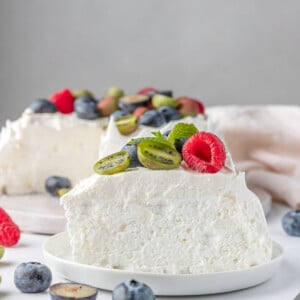
Berry Pavlova Cake
Ingredients
For the Pavlova Meringue
- 4 large egg whites, (about 140 g) room temperature
- 250 grams caster sugar, can be substituted with 250 grams of powdered sugar
- 1 tsp cream of tartar
- ½ tsp vanilla extract
- 1 tsp lemon juice
- 2 Tbsp corn starch
- pinch of salt
For the Whipped Cream
- ¾ cup heavy whipping cream, cold
- 2 Tbsp powdered sugar, scooped, and then sifted
- 1 tsp lemon juice
- 1 tsp vanilla extract
- 1 cup fresh berries/fruits , washed and cut
Instructions
- Preheat oven to 250F.
- With a pencil trace a 7” circle on a piece of parchment paper. Flip the traced side down and place parchment paper on the baking sheet.
- Dip a paper towel in a little bit of vinegar and run it thru the inside of the bowl and whisk. Wipe clean with another piece of dry paper towel.
- In a cleaned bowl transfer room temperature egg whites and salt. Whisk on medium speed until frothy. Make sure to check the bottom of the bowl to make sure all the egg whites have become frothy. They will turn white in color but will be soft, yet they will start to leave whisk marks. No liquid egg white should be on the bottom of the bowl.
- Add cream of tartar and whisk to incorporate.
- Turn the mixer speed to medium-high and start adding sugar one teaspoon at a time. Do so in 5-10 second increments. This is to ensure the sugar has time to dissolve and the meringue is not deflated by a large amount of sugar.
- Once all sugar is in continue whisking until it completely dissolves. (Please read notes for the easy powdered sugar version. ) To test – stop the mixer and run a little bit of the meringue in between your fingers. No sugar granules should be felt. The mixture will be stiff and glossy.
- Add in lemon juice, vanilla, and corn starch. Mix with the spatula to incorporate.
- Spoon the meringue onto the prepared baking tray. Even it out with a palette knife until the traced circle is filled and you have an even layer of meringue.
- To add cuteness, take a spatula and drag it from the bottom up making the lines.
- Place pavlova into the oven for 10 minutes. Make sure you place it in the middle rack or in the position where your oven has the most even heat.
- After ten minutes, without opening the oven, dial down the temperature to 200F.
- Bake for 2 hours.
- Without opening the oven, turn off the heat. Let the meringue cool down in the oven. Mine took about 3 hrs. You can turn the oven off and leave pavlova in the oven overnight, to cool down.
- Once the pavlova has cooled, make the whipped cream.
- In a bowl of a stand mixer place heavy cream and whip until the soft peaks. Add powdered sugar and whip until thick. Don’t overwhip. Whisk in lemon juice and vanilla. Let it incorporate.
- Transfer the whipped cream on top of your pavlova cake.
- Top with fresh berries/fruits.
- Serve right away. Pavlova Cake must be consumed the same day it is made. Leftovers must be refrigerated but they most likely will get soft and soggy.
Notes
- Allow pavlovas to rest in the warm oven 30 minutes before removing them to make sure the exterior dries well.
- Be sure to preheat the oven so you can get the pavlovas right into the oven. Don’t like it sit out for long before baking of else the form of it will start melting.
- Pavlova Cake must be consumed the same day it is made. Leftovers must be refrigerated but they most likely will get soft and soggy.
- Egg whites whip better when at room temperature but they separate easier when cold. Plan ahead by separating the eggs beforehand and leaving the egg whites out so they come to room temperature.
- Make sure there are no egg yolks present in the egg whites as the fat from the egg yolks will affect the egg whites’ ability to create a foam-like structure.
- I highly recommend using a scale to get the right amount of egg whites. Eggs vary in size so the scale ensures that you can measure the whites accurately.
- The bowl must be clean and dry so the eggs can whip up effortlessly. Use a stainless steel or glass bowl if possible as plastic bowls can retain a film of grease from previous uses.
- Similarly, the utensils such as the whisk are dry as well.


How much salt to add to the egg whites?
Just a pinch